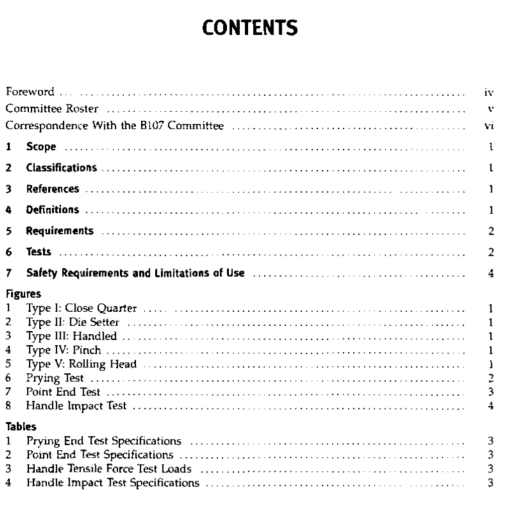ASME B107-60 pdf download

ASME B107-60 pdf download Pry Bars
handle. additional material that is securely attached tothe body and is to be gripped during use.
poimt erd: portion of bar having a tapered, round . cross-sectional area that is intended for aligning applicatians.prging edge: edge formed by the tapering of the chiselend or claw end.
prying end: portion of bar having a chisel end or aclaw end.
safery message: infornation inprinted on or affixed tothe bar that is intended to promote safety.
shall and shouid: mandatory requirements of this Stan-dard are characterized by the word “shall.” If a provisionis of an advisory nature, it is indicated by the word”should” or is stated as a recommendation.
5 REQUIREMENTS
Pry bars shall pass the tests specified in para. 6 asapplicable.
5.1 Design
5.1.1 Type l: Close Quarter. Pry bars shall have asharply bent chisei end providing leverage in lirnitedspace applications and a pointed end for alignmentapplications.
5.1.2 Type l: Die Setter. Pry bars shall have a benthalf loop chisel end fot separating or prying applicationsand a straight chisel end for scraping or prying-
5.1.3 Type Il: Handled.Pry bars shall have a slightlybent chisel end for separating, scraping. or prying appli-cations and a handle grip.
5.1.4 Type V: Pinch. Pry bars shall have a slightlyberit chisel end for separating, scraping.or prying appli-cations and a pointed end for alignment applications.5.1.5 Type V: Rolling Head. Pry bars shall have aormed rounded chisel end that acts as a fulcrum toprovide leverage and a pointed end for alignnent appli-cations.
5.2 Materials
The rnaterials used in the manufacture of pry barsshall be such as to produce pry bars confornrting to therequirements specified herein.
5.3 Mechanical Properties
Pry bars shall have a maxirnum hardness of 50 HRCor equivalent.
5.4Surface Conditions
Pry bars shail be free of norfunctional sharp edges,points, and surface rougturess that could inflict personalinjury to the user or adversely affect performance.
6TESTS
Many tests required herein are inherently hazardousand adequate safeguards for personne! and propertyshall be employed in conducting such tests. Tests shailbe conducted at a temperature between 40F and 90°F.Separate (new) samples shail be used for each test.Failure to meet the requirements of the applicable tcstsindicates that the pry bars do not cormply with thisStandard.
6.1 Hardness
Hardness determination shall be made in accordancewith ASTM E18.
6.2 Prying Tests
6.2.1 Prying End Test. The load shall be applied ncarthe middle of the handle or grip area of the piy bar (secFig.6).Apply a slow, steady load to the pry bar to meetthe torque specified in Table 1. If the blade or up fails,takes a permanent set, or if the handle loosens from thepry bar. the pry bar has failed this test.
6.2.2 Point End Test.The load shall be applied nearthe iddle of the handie or grip area of the pry bar iseeFig.73.Apply a slow,steady load to the pry bar to meetthe minimum bend angle specified ir Table 2.The pry bar shall nut fracture before the minimum bend angle is achiet-cd 6.3 Handle Solvent Resistance Test Assembled pry bar handles shall be fully immersed tn the test fluids specified (new samples shall bc used for each test fluid) for 15 rnin to 20 mm at rmnl temperature, rcrnoved, and let stand for 24 hr to 18 hr. Test fluids are SAE 11703 brake fluid, gasoline, ethylene glycol, and ethyl alcohol. There shall be no significant swelling nor surface attack of the material being tested.
6.4 Handle Tensile Force (Pull Apart) Test Assembled pry bar han dl s 5 h ~ H not break, lcawn, or separate from the p~ bar when subjected to the force specified in Tablc 3.
6.5 Handle Impact Test Set! Table 4 and Fig. 8.
6.5.1 The test plate shall have a hardnms of 13 HRC to 50 HRC. 6.5.2 The test plate shall rest on 2 solid foundation.
6.5.3 The s td i n g weight shall fall freely through a ~XrI1 eE.s tube having an innrr dirnens~on slightly larger than the weight.









